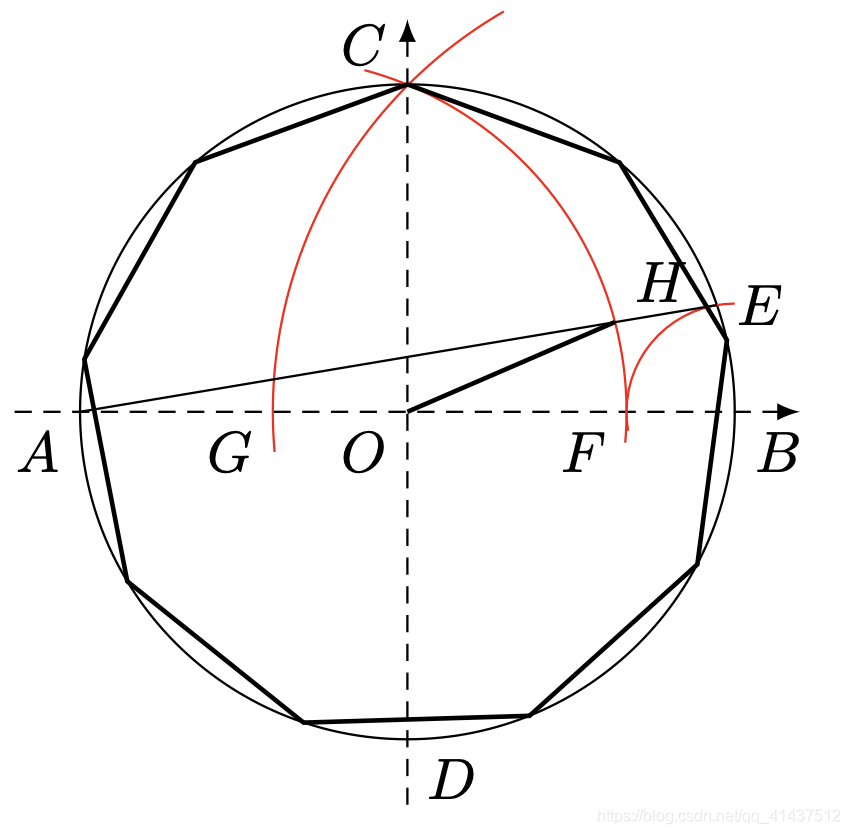做法
- 作圆的垂直中心线
A
B
,
C
D
AB,\,CD
AB,CD;
- 以
B
B
B为圆心,
B
C
BC
BC为半径作圆弧与
A
B
AB
AB交于点
G
G
G;
- 以
G
G
G为圆心,
G
C
GC
GC为半径作圆弧交
A
B
AB
AB于
F
F
F点;
- 以
B
B
B为圆心,
B
F
BF
BF为半径作圆弧交圆周于
E
E
E点;
- 连接
A
E
AE
AE交圆弧
C
F
^
\widehat{CF}
CF
于
H
H
H点;
- 连接
O
H
OH
OH,
O
H
OH
OH即为内接正九边形的边长.
图形

代码
\documentclass[tikz,border=3pt]{standalone}
\usetikzlibrary{calc}
\usetikzlibrary{intersections,through}
\begin{document}
\begin{tikzpicture}[]
% 标记点A,B,C,D,O
\coordinate [label=below left:$A$] (A) at (0,0);
\coordinate [label=below right:$B$] (B) at (4,0);
\coordinate [label=above left:$C$] (C) at (2,2);
\coordinate [label=below right:$D$] (D) at (2,-2);
\coordinate [label=below left:$O$] (O) at (2,0);
% 圆o
\draw [name path=o] (O) circle (2);
% AB, CD为圆的垂直中心线
\draw [densely dashed,-latex,name path=AB] ($(A)!-.1!(B)$) -- ($(A)!1.1!(B)$);
\draw [densely dashed,latex-,name path=CD] ($(C)!-.1!(D)$) -- ($(C)!1.1!(D)$);
% 以B为圆心, BC为半径
\path [name path=oCG]
let
\p1=($(B)-(C)$),
\n1={veclen(\x1,\y1)}
in
(B) circle (\n1);
% 标记圆弧与AB的交点G
\path [name intersections={of=oCG and AB}]
coordinate [label=below left:$G$] (G) at (intersection-1);
% 绘制弧段
\draw [red]
let
\p1=($(B)-(C)$),
\n1={veclen(\x1,\y1)}
in
(G) arc (180:120:\n1)
(G) arc (180:185:\n1);
% 以G为圆心, GC为半径
\path [name path=oCF]
let
\p1=($(G)-(C)$),
\n1={veclen(\x1,\y1)}
in
(G) circle (\n1);
\path [name intersections={of=AB and oCF}]
coordinate [label=below left:$F$] (F) at (intersection-1);
\draw [red]
let
\p1=($(G)-(C)$),
\n1={veclen(\x1,\y1)}
in
(F) arc (0:75:\n1)
(F) arc (0:-5:\n1);
% 以B为圆心, BF为半径
\path [name path=oEF]
let
\p1=($(B)-(F)$),
\n1={veclen(\x1,\y1)}
in
(B) circle (\n1);
\path [name intersections={of=o and oEF}]
coordinate [label=right:$E$] (E) at (intersection-1);
\draw [red]
let
\p1=($(B)-(F)$),
\n1={veclen(\x1,\y1)}
in
(F) arc (180:90:\n1)
(F) arc (180:190:\n1);
% 连接AE交圆弧CF
\draw [name path=AE] (A) -- (E);
\path [name intersections={of=oCF and AE}]
coordinate [label=above right:$H$] (H) at (intersection-1);
% 连接OH
\draw [thick] (O) -- (H);
% 找到其他点
\path [name path=o2]
let
\p2=($ (O) - (H) $),
\n2={veclen(\x2,\y2)}
in
(C) circle (\n2);
\path [name intersections={of=o2 and o}]
coordinate [] (C1) at (intersection-1)
coordinate [] (C8) at (intersection-2);
\path [name path=o3]
let
\p2=($ (O) - (H) $),
\n2={veclen(\x2,\y2)}
in
(C1) circle (\n2);
\path [name intersections={of=o3 and o}]
coordinate [] (C2) at (intersection-2);
\path [name path=o4]
let
\p2=($ (O) - (H) $),
\n2={veclen(\x2,\y2)}
in
(C2) circle (\n2);
\path [name intersections={of=o4 and o}]
coordinate [] (C3) at (intersection-2);
\path [name path=o5]
let
\p2=($ (O) - (H) $),
\n2={veclen(\x2,\y2)}
in
(C3) circle (\n2);
\path [name intersections={of=o5 and o}]
coordinate [] (C4) at (intersection-2);
\path [name path=o6]
let
\p2=($ (O) - (H) $),
\n2={veclen(\x2,\y2)}
in
(C4) circle (\n2);
\path [name intersections={of=o6 and o}]
coordinate [] (C5) at (intersection-1);
\path [name path=o7]
let
\p2=($ (O) - (H) $),
\n2={veclen(\x2,\y2)}
in
(C5) circle (\n2);
\path [name intersections={of=o7 and o}]
coordinate [] (C6) at (intersection-1);
\path [name path=o8]
let
\p2=($ (O) - (H) $),
\n2={veclen(\x2,\y2)}
in
(C6) circle (\n2);
\path [name intersections={of=o8 and o}]
coordinate [] (C7) at (intersection-1);
% 绘制正九边形
\draw [thick] (C) -- (C1) -- (C2) -- (C3) -- (C4) -- (C5) -- (C6) -- (C7) -- (C8) -- cycle;
\end{tikzpicture}
\end{document}





























 6099
6099

 被折叠的 条评论
为什么被折叠?
被折叠的 条评论
为什么被折叠?










